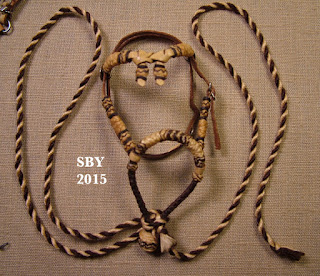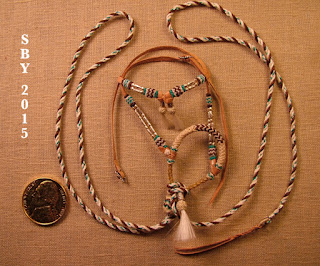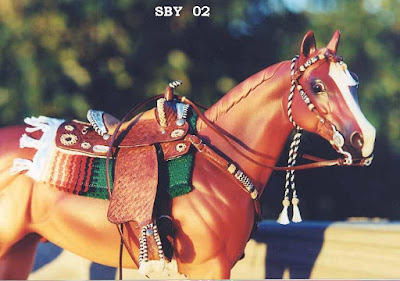Nothing would solve the mystery except a closer look, preferrably in hand. In an excess of luck I managed to purchase the piece. Truth at last: I had not made it. Thus was born this post, which will closely examine this newfound and incredible piece of model braidwork, and compare its work to mine at six different places or parts: interweaves, brow conchos, buckles, tassels, snaphooks and mecates. What a splendid chance to educate the public. Of course, it also hopes to answer the question: WHO DUN IT??
The story begins last fall (October 2015) with an ad in MH$P.
The phrase 'double take' describes my actions well. I did indeed 'take' more than once. I saved the 2 Harley pictures, printed them out, wrote to the seller, stared at that thing I can't tell you how many times. The set appeared to be of very high quality. Its design and color choice was exactly like something I would've done. The workmanship and execution, however, made me pause... were what grabbed my attention in the first place. The pure-rawhide braiding was too thick... too coarse... the mecate was wrong, too simple. But mecates can be replaced -- easily retied!! Last, first and most, the whole thing looked like it had painted interweaves instead of my standard braided ones. I've never done painted ones. The heel knot, in particular, I could not remember making...
Oh, I was confused, not to mention exasperated!!
This is a good view of the 'braided-and-wrapped' approach of the pure-rawhide (central) parts of the breastcollar. The buttons were formed from 3-strand-braided sinew, then cut in short sections and wrapped around the lace, and glued down. This method gives a fine appearance of scale-model braided rawhide, and is mentioned in my Guide. But TSII tack doesn't use it...
Everybody in the model-tack-collecting world should know that these two scrapbooks exist.
Here we see the Grey (1979 - 2005) and the Brown Braidwork (2006 - Current). Within the historical limitations of no camera until 1983, and only gradual growth of record-keeping by picture until about 1991, they document every piece of model braidwork ever made by the Timaru Star II (TSII), me. Digital camera technology entered in 2006 and printing my own pictures entered in 2010. I am always referring to these priceless records (like, for blogging!). When I couldn't find this hackamore and breastcollar set in either the Grey or the Brown, I knew I had a real mystery case.
The seller told me it had been sold to her by old hand S. Taylor, a tackmaker I'd known for decades, and who said it had been made by me. Certainly I trusted Taylor -- she had no reason to lie. The mecate, the seller thought, came from her hand.
Photo-shooting this piece was a pleasure. Its yellow-gold-and-black color looked best on a golden-with-black horse, and I found a saddle in my collection which matched beautifully. This saddle (above), with its dense glued-on edge braid, is by Kathy Wiggins circa 1998. So let's take a closer look at the Harley Hackamore, and compare it with what is known about TSII pieces. First and foremost, look at the interweaves (zigzag contrasting rings in braided buttons). The Harley has painted (or drawn-on) ones, done in a color exactly matched to its dark brown mecate. It is a supreme example of this technique. Painting allows terrific crispness, perfect spacing and sizing, and gives more zigzags than would be possible using thread. Of course it's easier! The blue arrows point to especially clear examples of painted interweave rings.
Now take a look at the TSII's Fancy's Hackamore with its actual braided, or woven in, interweave rings. The effect of braided thread is more 3-dimensional than drawn ones.
The Harley has a single pair of brow conchos. They are by Carol Williams of Rio Rondo (thank you Carol for establishing such a high standard!). While the TSII did use these conchos, such pieces are rare (and old). Mostly I used etched Rio Rondo conchos, and after about 2008 I started making my own, either from hot-fixes or from actual metal (aluminum or silver). [Al or Ag] Most, if not all, of my hackamores contain metal beads or crimps of some sort... the Harley doesn't.
Another sure clue is the buckles. The Harley's buckles are classic S-shaped ones:
The TSII almost always uses wire ones in which the ends have been looped over, or, as the Guide names them, "double-looped" friction buckles:
Since September 2001, the TSII nearly always uses twisted-wire buckles:
The Harley Hackamore has a California style tied-knot browband. When the TSII employs tied-knot browbands, there is almost always a pair of tassels on their tips. I say "almost" because there have been cases where there weren't tassels! (Portraits!) But with a set that has this much detail and knotwork effort, (this much psychic work) I would almost certainly have put in tassels. To me they feel required after a certain level of detail has been reached.
Fancy's Hackamore:
Here's an example from 2002, fourteen years ago:
Tied-knot brow tassels, braided interweaves, handmade twisted-wire double-looped buckles: they're all there. (TSII #425.)
Another difference with the Harley Hackamore is the snaphook. It clearly has the soldered Rio Rondo hook:
I have never used these hooks... I can say that with absolute certainty. The TSII uses plated spring-type snaphooks on its martingales:
This time I've chosen an example from twelve years ago (TSII #441). Note the buckle: hammered handmade double-looped wire. Since the martingale is hiding under the horse, not as much effort goes into its buckle; sad but true. : )
I have mentioned that the Harley Hackamore's mecate is a big clue. Assuming it is original, could it have been by me? Did I ever make 2-color twist (as opposed to 2-color braided) mecates? According to the Grey scrapbook, I did... but only in 2001, and they looked quite different. They had a braided-thread strand for the contrast:
On the left is a hackamore that went to Karen Grieve of England; on the right, a hackamore that went to Angela Giddings of Oregon. Matching breastcollars, aye... TSII mecates such as these had braided buttons on their tassel ends and leather poppers on the tails. Much better to look at my oldest mecates, prior to 2000 when I learned to spin thread:
(Both of these went to R. Nikolaidis in Germany.) Obviously braided, not spun.
So, WHO DUN IT??
I have looked long and hard through my collection of pictures of other people's tack (snatched off the web: I confess: but we try to carefully label). I have contacted other tackmakers and gotten responses. I will continue to do so. I can guess at those who did NOT make it more easily than I can guess who did, and here are some whom I think (or know) did NOT make the Harley Hackamore:
Heather Moreton
Danielle Hart
Jacquee Gillespie
Ulrike Appelt of Germany
Evelyn Munday
Donna Allen
Here is my list of those who MIGHT have made it. It includes model braiders active long ago who might have gained more experience and skill as time has gone by. The "long shots" are just that, folk whom I believe would have a slim, but just possible, chance of having created it.
Chris Armstrong
Emma Harrison
Kelly Maurer
Kim Smith
Linda Spiesschaert
Emily McFadden (long shot)
Lauren Islip (long shot)
Susan Monty (long shot)
Suzanne Adams (long shot)
In the course of writing Taylor a letter, inquiring about this hackamore (I can't find any email address for her), it came to me that the most likely answer is the most obvious, most common and yes most frustrating. Most likely (oh, I hate Occam's Razor -- he has cut me so many times!) she simply forgot, and, casting about for a famous name whose work looked like this, landed on me.
It is a beautiful piece, and I am lucky to have it. If it's this good, why are they claiming it was made by somebody else?
Anonymous has made the most model tack pieces of all.



















